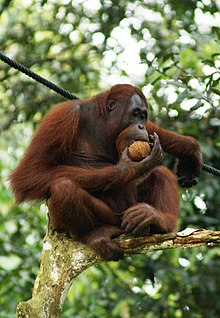Ponginae
| Ponginae Temporal range:
| |
|---|---|

| |
| Pongo sp. (orangutan) | |
| Scientific classification | |
| Domain: | Eukaryota |
| Kingdom: | Animalia |
| Phylum: | Chordata |
| Class: | Mammalia |
| Order: | Primates |
| Suborder: | Haplorhini |
| Infraorder: | Simiiformes |
| Family: | Hominidae |
| Subfamily: | Ponginae |
| Genera | |
|
Lufengpithecus | |
Ponginae is a subfamily in the family Hominidae. Once a diverse lineage of Eurasian apes, it is now represented by two species of orangutans, the Sumatran orangutan (Pongo abelii), and the Bornean orangutan (Pongo pygmaeus). Both species of orangutan are now listed as critically endangered by the IUCN.[1][2]
Evolutionary history
The first pongine genera appear in the Miocene, Sivapithecus and Khoratpithecus,[3][4] six or seven million years before evidence of orangutans was found from Pleistocene south-east Asia and southern China.[5] Ponginae may also include the genera Lufengpithecus, Ankarapithecus, and Gigantopithecus. However phylogenetic analysis in 2004 which originally found Lufengpithecus and Ankarapithecus to be most closely related to the orangutan gave different results "under an analytical method that attempted to reduce stratigraphic incongruence",[6] instead placing them on the base of the stem of the African ape-human clade.[3]
The most well-known fossil genus of Ponginae is Sivapithecus, consisting of several species from 12.5 million to 8.5 million years ago. It differs from orangutans in dentition and postcranial morphology.[6]
Taxonomy
Ponginae[7]
- Lufengpithecini†
- Lufengpithecus
- Lufengpithecus lufengensis
- Lufengpithecus keiyuanensis
- Lufengpithecus hudienensis
- Lufengpithecus
- Sivapithecini†
- Ankarapithecus
- Ankarapithecus meteai
- Sivapithecus
- Sivapithecus brevirostris
- Sivapithecus punjabicus
- Sivapithecus parvada
- Sivapithecus sivalensis
- Sivapithecus indicus
- Gigantopithecus
- Gigantopithecus bilaspurensis
- Gigantopithecus blacki
- Gigantopithecus giganteus
- Ankarapithecus
- Pongini
- Khoratpithecus†
- Khoratpithecus ayeyarwadyensis
- Khoratpithecus piriyai
- Khoratpithecus chiangmuanensis
- Pongo (orangutans)
- Pongo hooijeri†
- Pongo weidenreichi†
- Sumatran orangutan, Pongo abelii
- Bornean orangutan, Pongo pygmaeus
- Khoratpithecus†
- Griphopithecini†
References
- ^ Template:IUCN2010.4
- ^ Template:IUCN2010.4
- ^ a b Finarelli, J. A.; Clyde, W. C. (2004). "Reassessing hominoid phylogeny: Evaluating congruence in the morphological and temporal data" (PDF). Paleobiology. 30 (4): 614. doi:10.1666/0094-8373(2004)030<0614:RHPECI>2.0.CO;2.
- ^ Chaimanee, Y.; Suteethorn, V.; Jintasakul, P.; Vidthayanon, C.; Marandat, B.; Jaeger, J. J. (2004). "A new orang-utan relative from the Late Miocene of Thailand" (pdf). Nature. 427 (6973): 439–441. doi:10.1038/nature02245. PMID 14749830.
- ^ Bacon, A. M.; The Long, V. (2001). "The first discovery of a complete skeleton of a fossil orang-utan in a cave of the Hoa Binh Province, Vietnam". Journal of Human Evolution. 41 (3): 227–241. doi:10.1006/jhev.2001.0496. PMID 11535001.
- ^ a b Taylor, C. (2011). "Old men of the woods". Palaeos. Retrieved 2013-04-04.
- ^ Haaramo, Mikko (2004-02-04). "Pongidae". Mikko's Phylogeny Archive.
